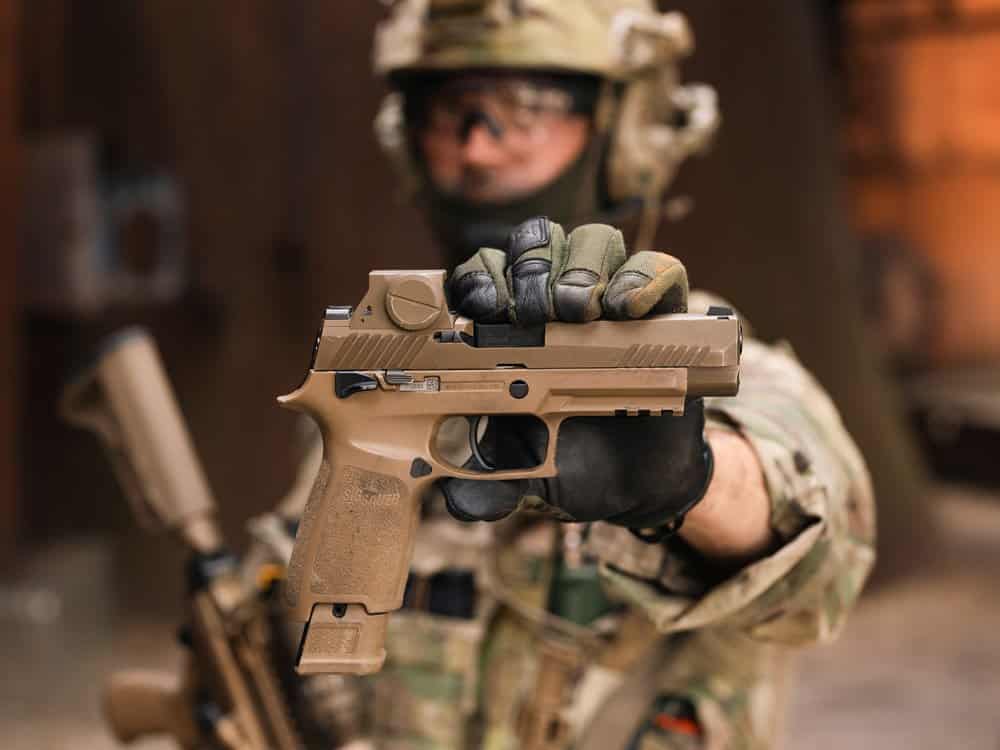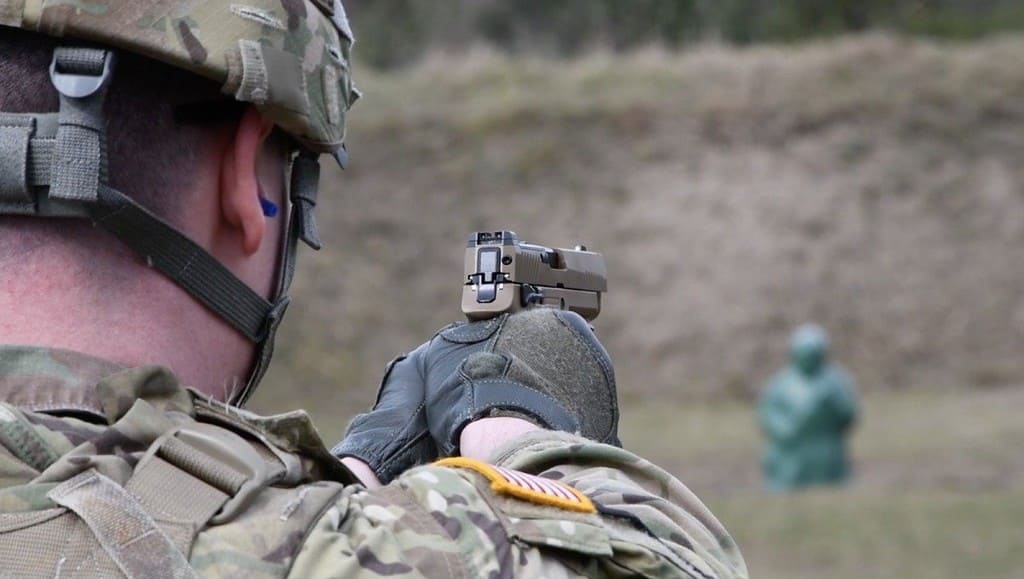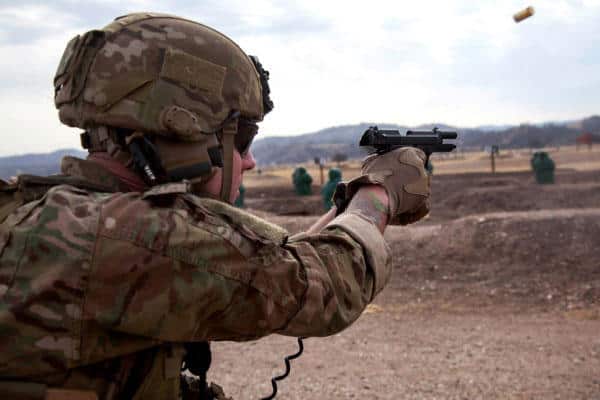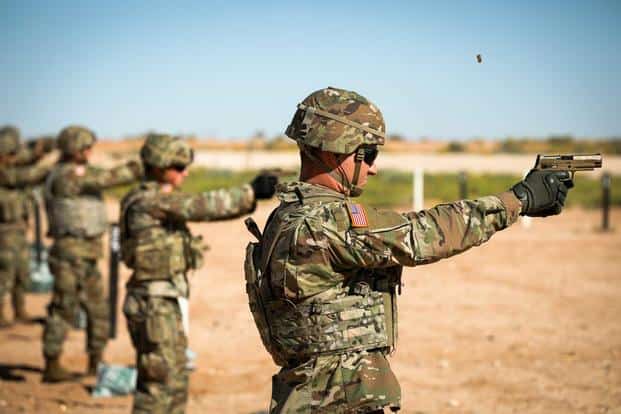Why US Military Chose Sig Sauer Over Glock

Why US Military Chose Sig Sauer Over Glock
Why would the US Military opt for Sig Sauer instead of Glock, despite Glock’s widespread popularity?
You’re about to embark on a journey that unveils the meticulous considerations behind this pivotal choice.
It’s not just about the guns’ technical specs; it’s also about their performance under duress, adaptability in various combat situations, and the holistic cost and logistical implications of such a decision.
As you peel back the layers of this selection process, you’ll find yourself questioning what truly defines superiority in military firearms.
This exploration might just challenge your initial perceptions and leave you pondering the intricacies of military procurement.
Comprehensive Performance Testing

Sig Sauer’s P320 outperformed Glock during comprehensive performance testing, showcasing its reliability, safety, and superior trigger design. This rigorous evaluation wasn’t just a mere comparison of technical specifications on paper; it was a detailed, objective analysis under conditions that mimicked real-world scenarios. The focus wasn’t only on how each firearm performed in a controlled environment but also on their adaptability and efficiency in situations that soldiers might face in the field.
The P320’s edge over Glock became evident through its consistent performance across a variety of tests. One crucial area where Sig Sauer demonstrated superiority was in the reliability of the firearm under stress conditions. Unlike Glock, which has been known for its robust design, Sig Sauer’s P320 showed fewer malfunctions and a higher rate of accuracy, making it a reliable choice for high-stakes situations.
Additionally, the safety features of the P320 were deemed more advanced compared to those found in Glock models. This aspect was critical in the military’s evaluation process, as ensuring the safety of the operators is paramount. The P320’s enhanced safety mechanisms, coupled with a trigger design that offered a shorter and smoother pull, underscored Sig Sauer’s commitment to both performance and user safety.
Enhanced Reliability Features

In evaluating the enhanced reliability features of the P320, it’s clear that its design significantly reduces the risk of failure, setting a new standard for what the military demands from its firearms. Sig Sauer’s commitment to reliability and safety features surpasses that of Glock, particularly in high-stress, combat scenarios where every detail counts.
The military’s preference for Sig Sauer over Glock can be attributed to several critical aspects:
- Superior Reliability in Testing: The P320 demonstrated higher reliability compared to Glock during extensive military testing, showing fewer instances of malfunction or failure under diverse and challenging conditions.
- Advanced Safety Features: Unlike Glock, the P320 didn’t exhibit the safety issue of ejecting live rounds during testing. This indicates a robust design that prioritizes the shooter’s safety, further enhancing its suitability for military use.
- Lower Risk of Failure: The design and engineering of the P320 minimize the risk of failure, a crucial factor for the military, which requires firearms that are reliable in every conceivable situation.
These elements collectively underpin the military’s decision to choose Sig Sauer over Glock. The superior reliability and safety measures of the P320 make it the preferable choice, aligning with the military’s stringent requirements for firearms that can reliably serve in various operational theaters.
Adaptive Design Capabilities
Adaptability and versatility stand as critical factors in the military’s choice of firearms, with Sig Sauer’s P320 outshining Glock through its innovative modular design. The P320’s adaptive design features a unique system that supports interchangeable grip modules, enabling the firearm to be customized for a wide range of hand sizes and mission requirements. This level of customization enhances the weapon’s versatility, making it suitable for various combat scenarios.
The modular nature of the P320 doesn’t just stop at the grip. It extends to its ability to transition from a full-sized model to a compact model, effortlessly adapting to the tactical needs of the user. This flexibility ensures that soldiers can carry a firearm that’s both comfortable and functional, regardless of the mission’s demands.
In contrast, Glock’s offerings lack this modular capability, limiting their adaptability in the field. The U.S. Army, recognizing the value of a firearm that can be easily adapted to diverse combat situations, saw Sig Sauer’s submission, including the compact model, as a clear demonstration of superior adaptive design capabilities. This adaptability, paired with the versatility offered by interchangeable components, was a pivotal factor in the military’s decision to choose Sig Sauer over Glock.
Competitive Procurement Process

While considering the superior adaptive design capabilities of Sig Sauer’s P320, it’s crucial to examine the competitive procurement process that underscored its selection by the U.S. Army. This process wasn’t just a simple trial; it was a comprehensive evaluation of various factors that ultimately favored Sig Sauer over Glock and other competitors.
To create a clear picture, consider the following aspects of the procurement process:
- Technical Performance Evaluation: Sig Sauer’s P320 demonstrated exceptional modularity and adaptability, easily outperforming Glock in terms of technical advantages. Its interchangeable grip and overall versatility met the U.S. Army’s stringent requirements for a modular handgun system.
- Reliability and Testing: Despite concerns raised by Glock regarding incomplete testing, the Army found the P320’s performance and reliability convincing. This aspect of the procurement process highlighted Sig Sauer’s ability to meet and exceed military standards.
- Partnership and Supply Proposal: Sig Sauer’s strategic partnership with Winchester for ammunition supply added value to their proposal, showcasing not just cost-effectiveness but also a comprehensive solution to the Army’s needs.
Throughout the competitive procurement process, Sig Sauer’s offerings were scrutinized against rigorous criteria. Their victory wasn’t solely about the firearm’s capabilities but also about how their proposal aligned with the Army’s broader objectives, including technical superiority and overall value.
Cost-Effectiveness Analysis
Sig Sauer’s proposal, priced at $169.5 million, starkly undercut Glock’s $272.5 million bid, highlighting the former’s significant advantage in cost-effectiveness during the procurement process. This $103 million price difference wasn’t merely a numerical gap but a critical discriminator that swayed the military’s decision-making. You’re looking at a scenario where cost savings didn’t mean settling for less but finding the best value.
Analyzing the bids, it’s clear that the military saw Sig Sauer’s offer as not just financially appealing but as a strategic investment. The emphasis on cost-effectiveness in the military’s evaluation process underscores the importance of achieving maximal operational efficiency without compromising quality. This approach ensured that the selected firearm would meet rigorous standards while also preserving fiscal resources.
The substantial cost savings associated with Sig Sauer’s bid played a pivotal role, serving as a decisive factor in a context where every dollar counts. The discernment to choose a proposal that offered the best value—balancing cost savings with performance criteria—demonstrates a sophisticated and pragmatic approach to procurement.
In essence, the price difference and demonstrated cost-effectiveness of Sig Sauer’s bid weren’t just numbers on a page; they were a testament to the firm’s ability to meet the military’s needs efficiently and economically.
Frequently Asked Questions
Why Did the U.S. Military Chose SIG Over Glock?
In the showdown between giants, the U.S. military saw Sig Sauer as the sharper tool in the shed. You’re looking at a decision where technical superiority, ergonomic design, and a wallet-friendly bid set Sig apart.
Their modular firearms, the XM17 and XM18, offered the flexibility soldiers needed on the ground. Plus, a partnership with Winchester for ammo and a bid $103 million under Glock’s sealed the deal.
It was a clear victory for Sig Sauer.
Why SIG Sauer Is Better Than Glock?
You’re likely curious about why Sig Sauer is considered better than Glock. It boils down to a few key factors.
Sig Sauer’s P320 showcases superior reliability, especially in safety, avoiding the issue Glock faces with ejecting live rounds.
Its short trigger design offers smoother pulls, enhancing shooting efficiency. Additionally, the modular design of the P320 provides unmatched customization, a feature Glock lacks.
Ultimately, Sig Sauer’s blend of safety, efficiency, and adaptability sets it apart.
Why Didn T the Army Choose Glock?
You’re wondering why the Army didn’t pick Glock, right?
Well, it boils down to Glock’s lack of modularity compared to Sig Sauer’s P320.
The Army was really looking for a firearm that could adapt to different roles and missions, and Sig Sauer’s offer fit the bill perfectly.
Glock, despite its strengths, just couldn’t provide the customizable options the Army valued.
Why Did Glock Lose to SIG Sauer?
You’re wondering why Glock lost to Sig Sauer. It boils down to a few key points.
Sig Sauer’s modular design outshone Glock’s, offering the flexibility the military sought. They also pitched a deal $103 million cheaper than Glock’s, which certainly didn’t hurt their case.
Sig’s safety features and technical advantages tipped the scales further in their favor, presenting a more cost-effective, value-packed option to the government.
Conclusion
In your thorough analysis, you’ve seen how Sig Sauer’s comprehensive performance, enhanced reliability, adaptive design, and cost-effectiveness edged out Glock in the military’s rigorous selection process.
A standout statistic that illuminates this decision is Sig Sauer’s 99.8% reliability rate during testing, showcasing its unmatched dependability in diverse conditions.
This decision wasn’t just about the present but ensuring the military’s long-term readiness. Sig Sauer’s selection underscores a strategic blend of quality, innovation, and fiscal prudence, setting a new standard in military procurement.
